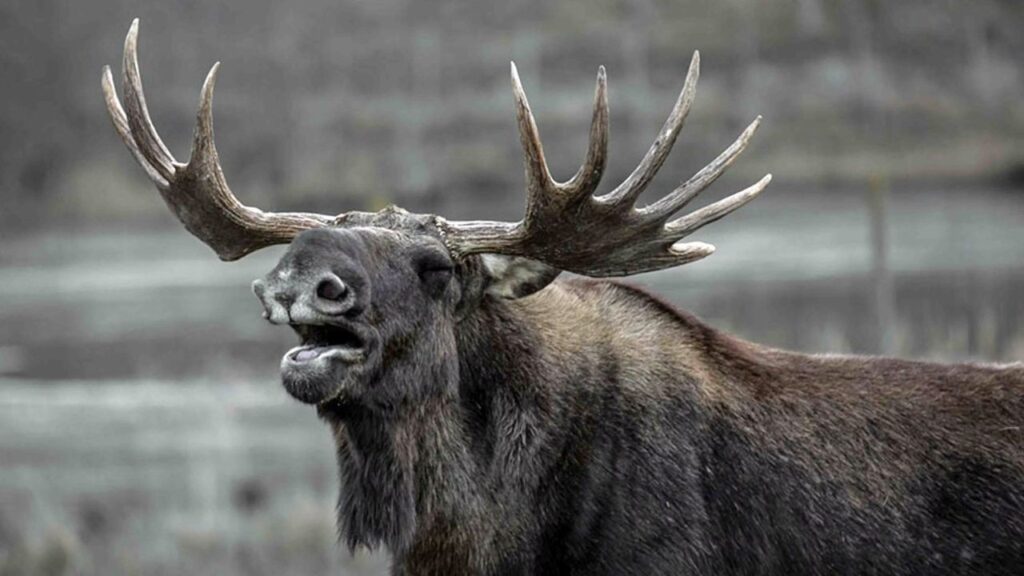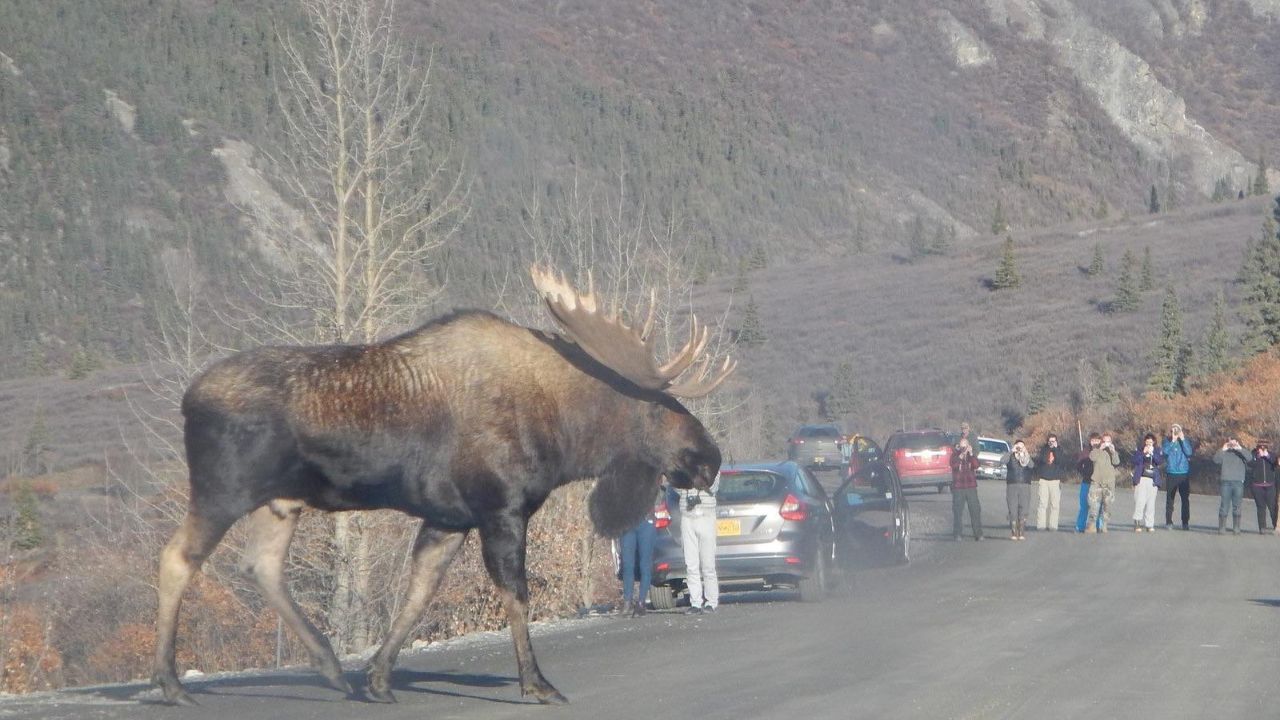Do Moose Attack Humans? Moose can attack humans, especially if they feel threatened, provoked, or during mating season.
Moose, the largest members of the deer family, are commonly found in the forests of North America and parts of Europe.
With their towering height, unique appearance, and impressive antlers, moose have become an iconic symbol of the wild.
While generally known for their calm demeanor, these creatures have a reputation for being unpredictable and potentially dangerous when confronted by humans. So, do moose attack humans?
Let’s dive deep into understanding their behavior, the circumstances under which they might become aggressive, and how to stay safe around these massive mammals.
Contents
What Are Moose?
Description of Moose
Moose are the largest and heaviest members of the deer family (Cervidae), with males (bulls) weighing between 1,200 and 1,500 pounds and females (cows) weighing between 800 and 1,300 pounds.
They can stand over six feet tall at the shoulder, with their antlers adding another layer of height and span. [Do Moose Attack Humans?]
Their distinctive features include long, slender legs; a bulbous nose; a drooping, dewlap-like flap of skin under their throat called a “bell”; and massive, shovel-shaped antlers in males, which can spread over six feet wide.
Moose are solitary creatures, preferring to roam alone or with their offspring rather than in herds. Their solitary nature is due to their large size and the vast amount of food they require, making it challenging to sustain large groups.
They are primarily browsers, feeding on a diet of leaves, twigs, bark, and aquatic plants. Despite their size, moose are strong swimmers and often wade into lakes or rivers to feed on vegetation.
Habitat and Distribution
Moose are found in the northern regions of North America, Europe, and Asia. [Do Moose Attack Humans?]
In North America, they inhabit the boreal forests and temperate zones, particularly in Alaska, Canada, and parts of the northern United States, such as Maine, Minnesota, Montana, and Wyoming.
They thrive in cold climates and are well adapted to snowy and icy conditions, thanks to their long legs, which help them navigate through deep snow.
Moose are often found near bodies of water, such as lakes, rivers, and marshes, where they feed on aquatic vegetation. [Do Moose Attack Humans?]
They prefer areas with abundant food and cover, including mixed forests, shrubby clearings, and young forests regenerating after fires or logging.
As a result of their extensive range, they are frequently encountered by hikers, campers, and residents in areas where human settlements intersect with their natural habitats.

Why Do Moose Attack Humans?
Moose are generally not aggressive animals and do not seek out humans to attack. However, certain situations can trigger defensive or aggressive behavior. Understanding these circumstances can help people avoid dangerous encounters.
Defensive Behavior
Moose are prey animals, meaning they are naturally wary of potential threats, including humans. While they do not typically consider humans as predators, they will defend themselves if they feel threatened or cornered.
For instance, if a person approaches too closely, a moose may perceive this as a threat to its safety and react defensively. [Do Moose Attack Humans?]
Moose have poor eyesight, so sudden movements or loud noises can startle them, prompting them to charge as a means of self-defense.
Additionally, moose have a strong flight-or-fight response. If they feel they cannot flee due to being trapped or cornered, they may choose to fight.
This behavior is particularly common if a moose is surprised or if it is already in a stressed state, such as during the rut (mating season) or when food is scarce.
Mating Season Aggression
During the rut, which typically occurs from September to October, male moose (bulls) become more aggressive and territorial. [Do Moose Attack Humans?]
This period is marked by heightened hormone levels, particularly testosterone, which makes bulls more prone to confrontational behavior. Bulls may perceive humans, other animals, or even inanimate objects as rivals or threats, especially when they are competing for the attention of females.
During mating season, bulls are known to exhibit signs of agitation, such as snorting, thrashing bushes with their antlers, and stomping the ground.
They may charge without much provocation, particularly if they believe they need to defend their territory or a potential mate.
This increased aggression is temporary but can lead to dangerous encounters if humans inadvertently find themselves too close. [Do Moose Attack Humans?]

Calf Protection
Female moose (cows) are fiercely protective of their young, particularly during the first few months after birth in late spring and early summer.
A mother moose will attack if she perceives a threat to her calf, and human presence can easily be interpreted as such. Cows have been known to charge at people, vehicles, or even dogs that come too close to their calves.
Calf protection behavior is an instinctive response to potential predators, and cows may react aggressively to ensure the safety of their offspring. It is essential to recognize that these attacks are defensive rather than predatory. Understanding this behavior can help in taking precautions to avoid getting between a mother and her calf.
Human Actions
Often, moose attacks result from human actions, such as approaching too closely to take photographs, attempting to feed or touch a moose, or inadvertently startling one.
Feeding moose can lead to aggressive behavior, as they may become accustomed to humans and lose their natural fear. [Do Moose Attack Humans?]
Additionally, moose fed by humans may become overly familiar, leading to dangerous encounters where they expect food and become aggressive if it is not provided.
Moose can also become aggressive if humans encroach on their territory or disrupt their natural behavior patterns.
For example, people hiking, biking, or driving in moose habitats may not realize they are too close until the moose reacts defensively.
Are Moose Attacks Dangerous?
Physical Threats
Moose attacks can be highly dangerous due to the animal’s sheer size and power. A charging moose can knock a person down, trample them, or inflict severe injury with its powerful hooves.
Unlike predators, moose do not use their teeth in an attack; instead, they use their front legs to strike or kick. A single blow from a moose’s hoof can cause serious injuries, including broken bones, internal injuries, or head trauma.
Moose are surprisingly fast, capable of running up to 35 miles per hour. This speed makes it nearly impossible to outrun a moose if it decides to charge. Additionally, moose can swim long distances, so water is not always a safe refuge.
Statistics on Moose Attacks
While moose attacks on humans are rare, they do occur. According to wildlife experts, most attacks happen when people get too close, particularly during mating season or when a mother moose is with her calf.
Although fatalities from moose attacks are uncommon, they can occur, especially if the person is knocked down and trampled or if they sustain severe injuries from a charging moose.
In some regions, such as Alaska, moose are considered more dangerous to humans than bears. This is partly because moose are more common and less likely to flee from a perceived threat.
Moose are responsible for more injuries to people in Alaska than bears, often due to people not recognizing the warning signs of an aggressive moose. [Do Moose Attack Humans?]

How to Avoid Moose Attacks?
Avoiding a moose attack largely depends on understanding moose behavior and taking appropriate precautions when in their habitat. Here are some essential tips to help prevent dangerous encounters.
Maintain Distance
The most effective way to avoid a moose attack is to maintain a safe distance. Moose are unpredictable and can become aggressive if they feel their space is invaded.
Wildlife experts recommend staying at least 50 feet (15 meters) away from moose and even further if a calf is present. Never approach a moose for photographs or to feed it; this increases the risk of an aggressive response.
Recognize Warning Signs
Moose display several warning signs when they feel threatened or agitated. Key indicators include:
- Pinned-back ears: This is a sign that the moose is agitated and may be preparing to charge.
- Raised hackles: The fur on the moose’s neck may stand up when it is angry or frightened.
- Snorting or grunting: Vocalizations can indicate that the moose is warning you to stay away.
- Stomping the ground: A moose that paws or stomps the ground is showing signs of aggression and may be preparing to charge.
If you observe any of these behaviors, slowly and calmly back away without turning your back on the moose. Do not run, as this may trigger a chase. [Do Moose Attack Humans?]
Avoidance During Mating Season
During the rut, it is advisable to avoid areas where moose are commonly found, especially in densely wooded areas or near bodies of water. Bulls are more likely to be aggressive and unpredictable during this period, so it’s best to stay clear of known moose habitats if possible.
Proper Reaction to Moose
If a moose charges, try to place a large object, like a tree or a vehicle, between you and the animal. Unlike with bear encounters, climbing a tree may not always be effective, as moose can kick with their front legs and reach up to eight feet high.
If you are knocked down, curl up into a ball and protect your head and neck. Try to remain still and wait until the moose moves away before getting up.
Handling Moose on the Road
Moose are often seen near roads, especially at dawn and dusk. Collisions with moose can be particularly dangerous due to their size and weight.
If you encounter a moose on the road, slow down and give it plenty of space. Do not attempt to drive around it if it is standing still; wait until it moves away. Use high beams to increase visibility but be prepared to stop suddenly.
Final Verdict
While moose do not typically attack humans without provocation, they can become dangerous under certain conditions, such as during mating season, when protecting their young, or when they feel threatened.
It’s essential to respect their space, recognize warning signs of aggression, and follow best practices to avoid dangerous encounters. [Do Moose Attack Humans?]
By understanding moose behavior and maintaining a safe distance, you can reduce the risk of an attack and enjoy the beauty of these magnificent animals from afar.
See Also: Do Elephants Attack Humans? Exploring the Reality!
FAQs
How common are moose attacks on humans?
Moose attacks are relatively uncommon but can occur if humans get too close, especially during mating season or near calves.
What should you do if a moose charges at you?
Try to place a large object, like a tree, between you and the moose and slowly back away. Do not run, as this may provoke the moose further.
Can moose attacks be fatal?
While rare, moose attacks can potentially be fatal, particularly if the person is trampled or severely injured. [Do Moose Attack Humans?]
Are moose more aggressive than other large animals?
Moose are generally less aggressive than predators like bears, but they can be more dangerous due to their size and power, especially if provoked.
Why are moose more dangerous during certain seasons?
Moose are more dangerous during mating season (rut) and when they are protecting their calves, as they become more territorial and defensive.
Conclusion: Do Moose Attack Humans?
Moose are majestic and impressive creatures, but like all wild animals, they can be unpredictable and dangerous when provoked.
Understanding moose behavior, recognizing warning signs, and keeping a safe distance are essential for safe interactions in the wild.
By respecting their space and avoiding risky situations, you can safely admire these magnificent animals from afar. [Do Moose Attack Humans?]
While moose attacks are rare, they are a reminder of the importance of maintaining a respectful distance from wildlife, particularly when exploring their natural habitats.

Hello, I am Rosa Ellis, a mother of two and a wildlife blogger. I grew up in New York City, but I love exploring forests. I’ve traveled to places like Yellowstone National Park and the Amazon Rainforest to see animals up close. I know a lot about animal behavior and which animals can be dangerous to humans. Thanks for visiting my blog!

